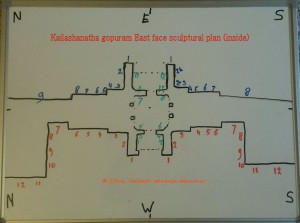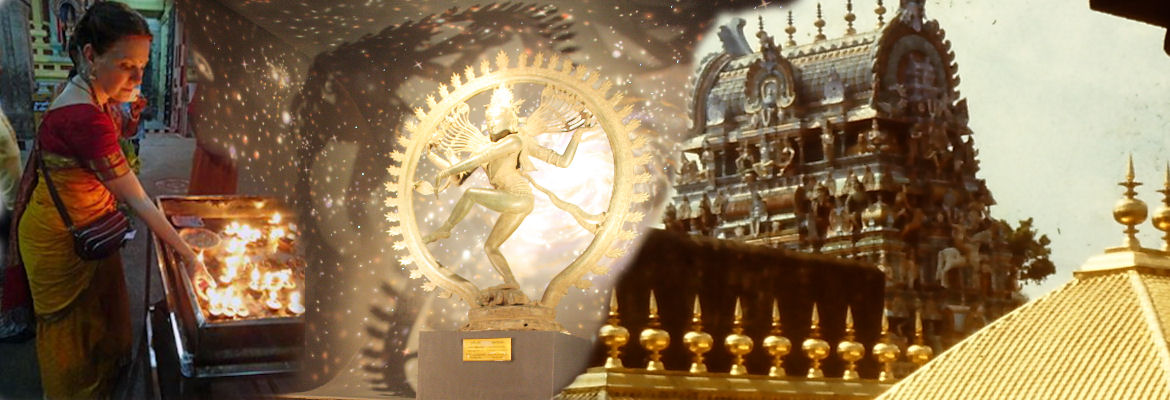
Notes and thoughts on the sculptural program of the gopuram of the Shri Kailashanatha temple of Ellora.
Now our attentions turns to the inner face of the gopuram of the Kailashanatha.
One of the things that is noticeable is the symmetry usually applied in lay-out and sculptural plan is not fully applied here. Also on the inside face there is one relief (SE 2a) that works around a corner. It is a warrior figure about to release an arrow from his bow on a chariot drawn my multiple horses and a multi-headed figure as charioteer. There are to divine figures from mythology ho are featured on a chariot. Surya and Tripurasamhara. Surya’s chariteer is Aruna is described as having no legs. Tripurasamhara has Brahma as charioteer. So this figure would be Tripurasamhara, Shiva burning the Three Demon Cities.
Around and above him are several miniatures, possibly illustrations of the purana of the Three Flying Demon Cities?
Two figures have been placed in narrow niches in the wall between two of the faces (SE 4 and NE 5). On the outside we don’t find any niche in the same place.
The unequal numbering between inside and outside, northern and southern wing, which is the result of the breaking of the symmetry illustrates it clearly.
Also the inner face of the outside wings are much lower than the outside. Small pillared halls have been excavated inside. The sculptural plan takes another shape and shows scenes with multiple characters, too damaged to easily dentify.
Udayan Indurkar offered identification to the figures of the NE face. I have followed this. In an article by D. Rajpal & K. Parkash, Femininity as Divinity, Depiction of Goddesses at Kailash Temple Ellora (Antrocom Online Journal of Anthropology 2014, vol. 10. n. 2 – ISSN 1973 – 2880) I have found a few more identifications and information. According to them both the divine coupes on the NE face are Kama and Rati. Both couples look alike. The identification may be direct. Except that everything I know of gopuram sculptural plans suggests that such repetitions are unlikely.
The Dvarapalas on this side have been identified by Aditya Banerjee as Jaya and Vijaya, dvarapalas for Vishnu. I am not sure how to distinguish the various sets of dvarapalas (4 different ones for Vishnu, the same for Shiva).
NE 01. Dvarapala
NE 02. Durga Mahishasuramardini
NE 03. Krishna Govardanadhara (according to Udayan Indurkar)
NE 04. Divine couple, Kama and Rati? (according to D. Rajpal & K. Parkash), if it is so, who
are the two divine flying figures above their heads?
NE 05. ? Male figure, two arms (facing north in narrow niche)
NE 06. ? female figure, two arms, holding a lotus in right hand
NE 07. Divine couple, Kama and Rati (Udayan Indurkar and D. Rajpal & K. Parkash), above
their head is ???
NE 08. Vishnu on Garuda in human form
NE 09. ? heavenly or court scene? (above an entrance, very damaged?)
SW 01. Dvarapala (one of the pair Jaya and Vijaya?)
SW 02. (a) miniatures
SW 02. (b) Shiva as Tripurasamhara, with Brahma as charioteer and the 4 Vedas as horses
SW 03. For armed figure holding a human head, a snake, a sword and ? or placed on his left
hip. (can’t see) Could be Bhairava, except he has a peaceful expression, no fangs.
SW 04. ? male figure, in the narrow niche facing South
SW 05. ? male figure, four arms?
SW 06. Dancing figure, torso turned, Shiva dancing?
SW 07. ? male figure dynamically depicted with one right leg on unclear figure/thing in lower left corner. With a spear or trident crossing in front, possibly with a figure impaled on it. Snake in upper left hand points to a form of Shiva. Could possibly be Kankalamurti?
SW 08. Long freeze connecting several scenes.
